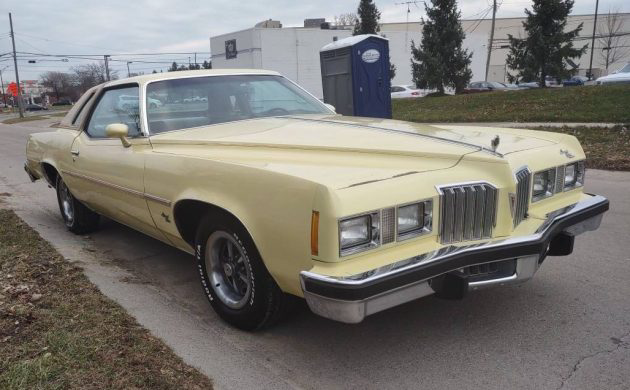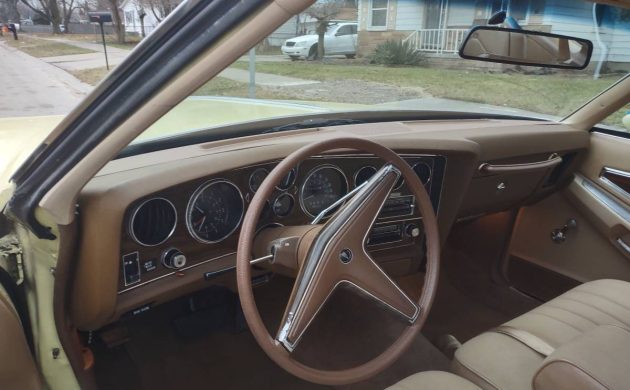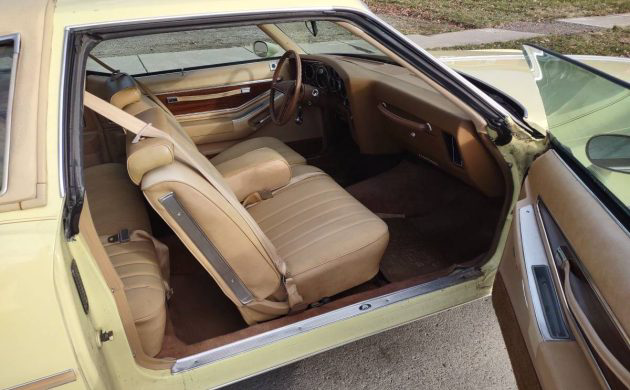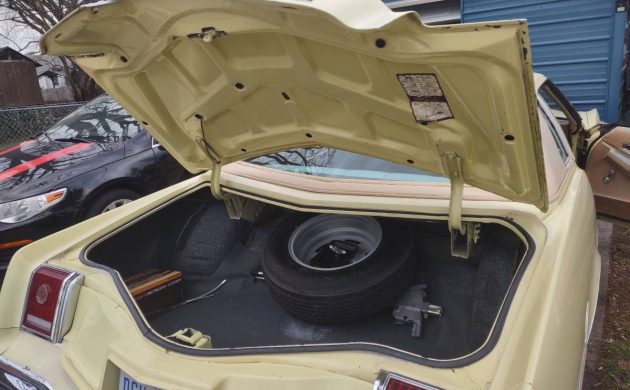It is hard to explain the seventies to anyone who wasn’t there to live through that quirky time in American history. How can you rationalize the fact that Americans purchased avocado green and poppy red major appliances by choice? As far as transportation goes, it is easy to explain the popularity of personal luxury coupes like this 1977 Pontiac Grand Prix coupe for sale on Craigslist in scenic Toledo, Ohio. This remarkably well-preserved time capsule car is a stunning example of the seventies’ most popular body style. With 79,000 miles on the odometer and few visible flaws, is this pastel-yellow beauty worth the $8,500 asking price?
While most of us bemoan the excessive number of lookalike SUVs on the road today, one must keep in mind that humans are at heart pack animals. Sort of like when one cow takes a notion to cross the pasture, all of the rest of the cows will follow. In the seventies, the great herd of humanity busied themselves with eating, sleeping, and moseying down to the local dealership to order up a personal luxury coupe. While everything from pickup trucks to station wagons could be purchased in almost every dealership at the time, customers wanted and got two-door cars that invariably had V-8 engines under the hood, automatic transmissions, some form of vinyl top, and a pillowy interior. The day of the muscle car had passed involuntarily, and the people had spoken. If they couldn’t go fast, then they wanted to be comfortable and look good. Or they wanted a van for, you know, reasons.
You could blame the political and financial climate for the fact that personal luxury coupes were the most popular product of the Big Three, particularly General Motors. Each of GM’s divisions had at least one of this type of vehicle to offer customers. These “A-Body” cars weren’t exactly fast or good handling cars in the corners. With a 55 MPH speed limit across the nation enforced by revenue-hungry cops, taking your time made perfect sense. Radar detectors were just starting to emerge in the seventies and cars just weren’t as comfortable at high speeds as they are now. Gas prices were starting to become an issue as well. Standing on the gas in a car choked down with smog pumps and catalytic converters was pretty much pointless unless you liked to hear the whooshing of burnt fuel exiting the over-muffled exhaust. If you wanted to see someone driving a car of this type fast, then you had to head to your nearest NASCAR race, where these cars were the “stock car” of choice despite the obvious differences.
If you were looking for an example for someone who had never seen or experienced a personal luxury coupe, then this 1977 Pontiac Grand Prix coupe is perfect for the job. The ad is scantily clad with details. We are told that this car “runs, rides, and drives A-1.” They also add the rather ambiguous “90 percent ready, very solid car, untouched.” Looking at the photographs leads one to believe that this car was pulled from a suburban garage after many years of hibernation and refuge from Toledo winters. It is so pristine that it takes me back to memories as a child of riding in my mother’s 1977 Oldsmobile Cutlass Supreme Brougham. The bodies for all of these GM coupes were almost identical, except for the nose and tail sections. Every once in a while, GM would haul out some special back glass or cut T-Tops into the roof just to garner more floor traffic in showrooms.
These cars were huge profit makers for General Motors. Once you got past the initial cost of the car itself, GM made sure you had a huge number of options to choose from to run the price up. Anything from power seats to cruise control could be had if you just checked the box. Those components made a lot of money for the company, as they could be used on anything from a Chevrolet to a Cadillac. Looking closely at the car you see here reveals a small number of options. Styled steel wheels, an AM/FM radio, and a 60/40 seat are the only things that jump out here other than the remarkable condition of this Grand Prix.
Sadly, these larger coupes will be replaced next year by smaller versions in the name of fuel efficiency and increased profits. Those smaller coupes would also set sales records until they too were replaced by front-wheel drive versions of the personal luxury coupe. While there are a few examples of this type of car still being sold, the herd moved along to other body types soon thereafter. However, those of us who remember the seventies look at a car like this and smile. Floating down the road in a smog-choked slow but comfy seventies coupe never appealed to me when I was younger. Seeing this car makes me wistful and wanting to put one in my garage. I cannot imagine finding a better choice than this Pontiac. Hopefully, it goes to someone who appreciates it and displays it for the rest of us to vicariously enjoy.
Do you remember riding in or owning one of these seventies’ personal luxury coupes? Do you think that this Pontiac is a great example of that type of vehicle? Please share your memories and opinions in the comments.







I’d LS this n GO !
Bought a new ’77 GP was a great ride!JP
I had a GP in 1976. I went from a full house Boss 302 to one of these but I don’t remember why. Strange decision but we all had a luxury coupe. Weird
Is it a 350 ? Love the GP model.
Would like the console shifter option.
I would THINK a 400 ?
My ‘77 had a 301. Couldn’t get out of its own way.
I had a new 1977 that was Roman Red with a white landau top, SJ model. It had the 400 engine.
I thought these cheaper versions had a 350, column shifter? Then I see the wide side moulding and the chrome on the bottom, plus some lettering on the fender that looks like a LJ or SJ?
I’m not sure what this is?
I just thought the higher end ones had a console, buckets and floor shifter, along with a 400 engine?
Just my oponion!
I bought a 77 LJ used in 81. Lots of bells and whistles for the time. Buckets, console, power windows and locks, cruise, tilt wheel, landau roof, rally wheels, but it had that anemic 301, 4bbl. As some other folks have said, it couldn’t get out of it’s own way. The only positives: it was gorgeous and rode awesome. I didn’t keep it too long.
I had one that I bought in the mid-90’s for maybe 500 bucks or so…It had the start of rust above the rear wheel wells. I used it for my work car for maybe 18 months before I got a great deal on a Renault 4 on the floor (more pickup, better gas mileage) and sold it on down the line. Comfortable seating, good cruising, disappointing gas mileage.
Scenic Toledo Ohio, that’s hilarious. I live a couple hours east of Toledo and it’s definitely seen better days. I like the car, not the color. Hunter green would look better with that interior, which is nice although lacking a console and the shifter on the column and not the floor. The author is right about the market changing. Not much demand for one of these now.
Somebody’s quick flip after telling another somebody that “nobody would want” that old car since it was post-1971, getting it for free or nearly free, then doing the standard minimalist presentation.
We had one that was the exact same color inside and out, except it was a 76. Ours was the SJ with a 400, swivel buckets, console shift, t-tops. Was a great car, not quite as big as our 72 Caprice, but we took the Pontiac on vacation and it wasn’t bad.
Most likely this is a 350 version. I’m not 100% sure, but I think the 301cid was a “no cost option “and of course the 400cid DID cost extra. The “gutless” 301cid was actually pretty efficient for the time. These comfy lounge cruisers with the 301cid could get close to 18-19 mpg, which was VERY GOOD for the 1970’s! True – they had a hard time getting out of their own way, BUT MAN – they were so classy, stylish, and EVERYBODY watched them as they drove by! I know I did – I loved ‘em – even though I was only 13yrs old. This one’s a keeper! Hope it gets a good home. Fantastic article too.
My wife and I had the exact same car with the exact same color. One of our favorite cars ever. It looked great and handled well. It felt safe with our three kids. It was a great car!
I’m wondering the same thing as Jeff. 90% ready. What does that mean and what’s the 10% that isn’t ready?
Great write up! My parents had a mid/late seventies Pontiac Bonneville in a sky blue color. Matching blue interior and painted wheels. Of course a white vinyl top. I’d love to see and sit in it again.
Owned a 72 G.P. With a 400 c.i. It was a nice handling car!
I had a 1975 with the 400 cid.
Once it got rolling on the highway, it was a pretty good car.
On the on ramp to the highway, it was like driving a dump truck, at least the pickup was similar.
I admit that I thought it was a great looking car. Mine was silver-grey.
Lousy paint.
Note the window cranks.
Yes I loved the styling of the 1969-77 Pontiac Grand Prix. Owned a 1974 and briefly a 1976. The car for sale still looks fantastic but is sparsely optioned. My had the 400 4 bbl V8 and was not drsigned to be a boy racer but could reach any top legal speed quuckly and cruise all day at low rpm doing it. 1977 400 V8 versions had lost 40 horsepowrr from the 1974 detuned for better mpg. Avoid a 301 slug at all costs. As far as handling Grand Prix models like mine had faster ratio steering, front sway bars, Radial Tuned Suspensions, and some road steering feel. The excessive overhang stretching a midsized car did make it a bit tougher cornering and parking with a hood longer than some standard sized models. But in its day nothing could toich its looks, handling components, big V8s and luxury options for the price of a mid sized mass produced car. Cars had technological advances in 50 years but look like turtle shells or squished turtle shells except for pony cars.
I would take a chance on this for around $5,000 and put the original engine & trans on a pallet shrink wrapped while a nicely rebuilt 455 pulled it down the road! Why waste $12k + trying to LS it, keep it all Pontiac for a fraction of that and keep the torque needed to move all that weight from light to light!